
A knot is an intentional complication in cordage which may be practical or decorative, or both. Practical knots are classified by function, including hitches, bends, loop knots, and splices: a hitch fastens a rope to another object; a bend fastens two ends of a rope to each another; a loop knot is any knot creating a loop; and splice denotes any multi-strand knot, including bends and loops. A knot may also refer, in the strictest sense, to a stopper or knob at the end of a rope to keep that end from slipping through a grommet or eye. Knots have excited interest since ancient times for their practical uses, as well as their topological intricacy, studied in the area of mathematics known as knot theory.
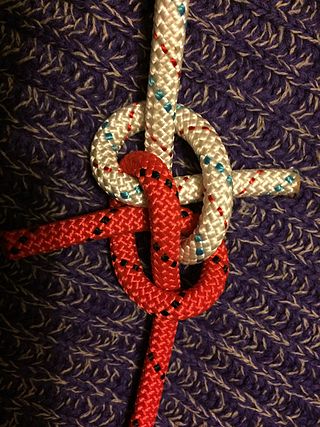
A zeppelin bend is an end-to-end joining knot formed by two symmetrically interlinked overhand knots. It is stable, secure, and highly resistant to jamming. It is also resistant to the effects of slack shaking and cyclic loading.

The Carrick bend, also known as the Sailor's breastplate, is a knot used for joining two lines. It is particularly appropriate for very heavy rope or cable that is too large and stiff to be easily formed into other common bends. It will not jam even after carrying a significant load or being soaked with water.
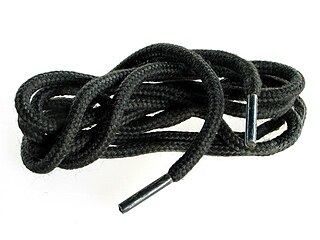
Shoelaces, also called shoestrings or bootlaces, are a system commonly used to secure shoes, boots, and other footwear. They typically consist of a pair of strings or cords, one for each shoe, finished off at both ends with stiff sections, known as aglets. Each shoelace typically passes through a series of holes, eyelets, loops or hooks on either side of the shoe. Loosening the lacing allows the shoe to open wide enough for the foot to be inserted or removed. Tightening the lacing and tying off the ends secures the foot firmly within the shoe. The laces can be tied in different shapes, most commonly a simple bow.
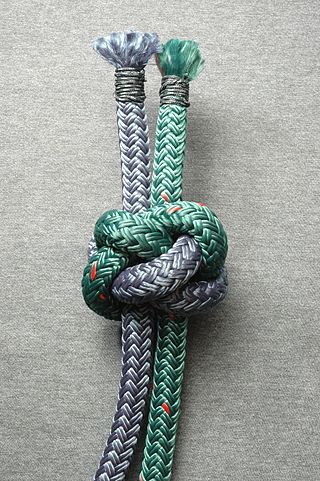
The diamond knot is a knot for forming a decorative loop on the end of a cord such as on a lanyard. A similar knot, also called the diamond knot, is a multistrand stopper knot, that is similar in appearance. To avoid confusion, it is advisable to call this knot the knife lanyard knot. This knot is a four strand diamond knot implemented in two strands. The knife lanyard knot is "tied alike" the Chinese button knot, "but they are worked differently." This knot is also used in Prayer ropes by Eastern Christians, who accredit the knot's creation to a legend relating to Saint Anthony the Great.
The sailor's knife lanyard knot, also called marling-spike lanyard knot, single-strand diamond knot, two-strand diamond knot, and Bosun's whistle knot.
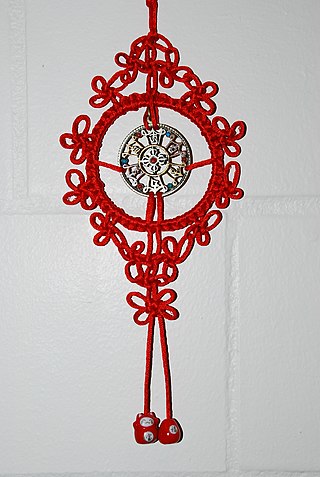
Chinese knotting, also known as zhongguo jie and decorative knots in non-Chinese cultures, is a decorative handcraft art that began as a form of Chinese folk art in the Tang and Song dynasty in China. This form of craft originated and was derived from the Lào zi culture which already existed in China since the ancient times. As a form of art, it is also called Chinese traditional decorative knots. Chinese knotting was later popularized in the Ming and spread to Japan and Korea. There are many different shapes of Chinese knots, the most common being butterflies, flowers, birds, dragons, fish, and even shoes. Culturally they were expected to ward off evil spirits similar to bagua mirrors or act as good-luck charms for Chinese marriages. Around the time of the Chinese new year festival, Chinese knot decorations can be seen hanging on walls, the doors of homes, and as shop decorations to add some festival feel. Usually, these decorations are red in color, which is a color associated with luck in traditional Chinese culture. They are also used to make the pan kou, the Chinese buttons, which are used to decorate the cheongsam.

Macramé is a form of textile produced using knotting techniques.

A stopper knot is a knot that creates a fixed thicker point on an otherwise-uniform thickness rope for the purpose of preventing the rope, at that point, from slipping through a narrow passage, such as a hole in a block. To pass a rope through a block, or hole, is to reeve it. To pull it out is to unreeve it. Stopper knots prevent the rope from unreeving on its own.
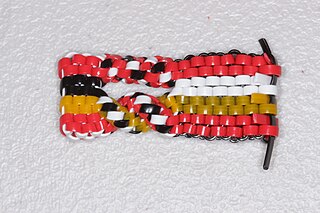
Scoubidou is material used in knotting craft. It originated in France, where it became a fad in the late 1950s and has remained popular. It is named after the 1958 song of the same name by the French singer Sacha Distel.

A Matthew Walker knot is a decorative knot that is used to keep the end of a rope from fraying. It is tied by unraveling the strands of a twisted rope, knotting the strands together, then laying up the strands together again. It may also be tied using several separate cords, in which case it keeps the cords together in a bundle. The traditional use of the knot is to form a knob or "stopper" to prevent the end of the rope from passing through a hole, for instance in rigging the lanyards which tension the shrouds on older sailing ships with standing rigging of fibre cordage.

The cow hitch, also called the lark's head, is a hitch knot used to attach a rope to an object. The cow hitch comprises a pair of single hitches tied in opposing directions, as compared to the clove hitch in which the single hitches are tied in the same direction. It has several variations and is known under a variety of names. It can be tied either with the end of the rope or with a bight.

The sailmaker's whipping is one of the most durable and stable of rope whippings known. According to The Ashley Book of Knots, "palm-and-needle whipping, or sailmaker's whipping, is the most satisfactory of all."

A friendship bracelet is a decorative bracelet given by one person to another as a symbol of friendship. Friendship bracelets are often handmade, usually of embroidery floss or thread and are a type of macramé. There are various styles and patterns, but most are based on the same simple half-hitch knot. They resemble a friendship that is strong and everlasting.
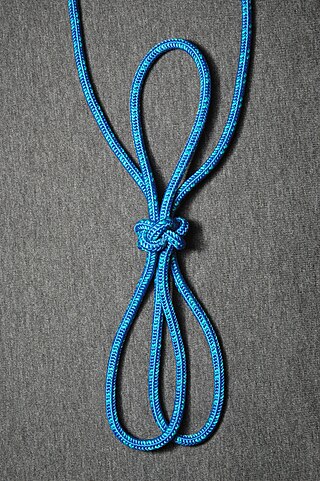
The fiador knot is a decorative, symmetrical knot used in equine applications to create items such as rope halters, hobbles, and components of the fiador on some hackamore designs. As traditionally described, it is a four strand diamond knot in which six of the eight ends loop back into the knot, thus allowing it to be tied with a single line. While a specific knot is discussed in this article, the fiador knot has also been treated as an entire class of multi-strand knots similarly made with a single line.

The basket weave knots are a family of bend and lanyard knots with a regular pattern of over–one, under–one. All of these knots are rectangular and lie in a plane. They are named after plait-woven baskets, which have a similar appearance.

The reef knot, or square knot, is an ancient and simple binding knot used to secure a rope or line around an object. It is sometimes also referred to as a Hercules knot. The knot is formed by tying a left-handed overhand knot between two ends, instead of around one end, and then a right-handed overhand knot via the same procedure, or vice versa. A common mnemonic for this procedure is "right over left; left over right", which is often appended with the rhyming suffix "... makes a knot both tidy and tight". Two consecutive overhands tied as described above of the same handedness will make a granny knot. The working ends of the reef knot must emerge both at the top or both at the bottom, otherwise a thief knot results.
The reef knot or square knot consists of two half knots, one left and one right, one being tied on top of the other, and either being tied first...The reef knot is unique in that it may be tied and tightened with both ends. It is universally used for parcels, rolls and bundles. At sea it is always employed in reefing and furling sails and stopping clothes for drying. But under no circumstances should it ever be tied as a bend, for if tied with two ends of unequal size, or if one end is stiffer or smoother than the other, the knot is almost bound to spill. Except for its true purpose of binding it is a knot to be shunned.

The Chinese button knot is essentially a knife lanyard knot where the lanyard loop is shortened to a minimum, i.e. tightened to the knot itself. There emerges therefore only two lines next to each other from the knot: the beginning and the end. The knot has traditionally been used as a button on clothes in Asia, thus the name.
The Chinese Button Knot is worn throughout China on underwear and night clothes. Buttons of this sort are more comfortable to lie on and to rest against compared to common bone and composition buttons, and they cannot be broken even by the laundry.
A Chinese tailor ties the knot without guide, flat on his table. But one may be more quickly and easily tied in hand by a modification of the sailor’s method of tying his knife lanyard knot (#787). The two knots are tied alike, but they are worked differently.




















